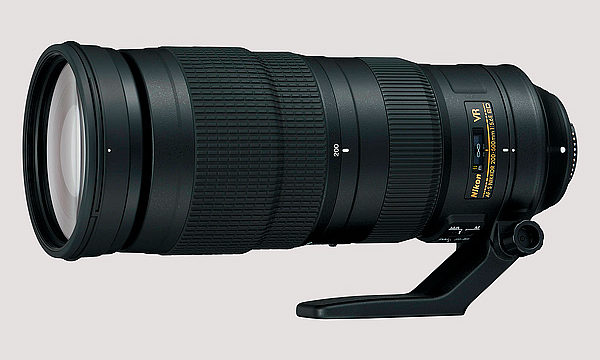
Nikon AF-S 200-500 VR review
Introduction
This is the first time I review Nikon gear so a little bit of background, in case you are wondering:
When I started digital photography back in 2001, my first DSLR camera was actually a Nikon D100, and gush it wasn’t a pleasant experience. The D100 was clearly not ready for prime time, it would take a minute or two to compress and then save its soft and noisy NEF files. With a buffer capacity of just 3 RAWs and the screw-driver type AF, the D100 was a dog and left a bad taste in my mouth. It wasn’t until 2004 when I purchased a Canon EOS-20D that I regained interest in photography and focused on photographing birds. At that time, Canon was way ahead of the competition in everything, AF, resolution, low-noise high-ISO, telephoto lenses and the list goes on and on. I gave Nikon another try in 2009, I purchased a Nikon D700, a D3S and borrowed a Nikon AF-S 500mm f/4 VR and used it alongside my then Canon EOS-1D Mark IV and the EF 500mm f/4 IS I at the time. This was to satisfy my own curiosity of whether there was anything better than Canon for photographing birds in flight. Once again I was underwhelmed by Nikon, the Nikon lens wasn’t as sharp as my Canon when rendering fine feather details, and performed poorly with extenders. The AF was slow for BIF and the 12-Mega pixel files lacked the “awe factor” when compared to my Canon rig. I thought I’d never see Nikon come back again. Fast forward to 2018, and yet here I am after replacing my entire long list of Canon equipment with Nikon. I will explain the reasons behind my switch at a later time. In this review I will just focus on the Nikon AF-S 200-500mm f/5.6 VR for bird photographers.
Note the images in they review are 1920 pixels wide and optimized for 4K/5K screens. they may not look optimal on the older screens.
Quick impression of Nikon bodies
I will cover the D5 and the D850 in detail but I want to quickly point out a few things that I like about these bodies and a few that I don’t. I love the round eye-piece that is raised more than Canon’s, makes it much easier to see the entire image when wearing glasses. The D850 finder in particular, looks much larger and brighter than the Canon EOS-5 D Mark IV. I love the touch screen on both Nikon’s it can be used for everything. On my EOS-1D X Mark II the touch screen was useless (only used for LV focus!) , on the EOS-5D Mark IV it did more stuff but still not as many functions as the Nikon’s. D850’s articulating LCD is nice too. I like the LED back-lit buttons, makes it easier to see in dim light. The D5 feels lighter than the EOS-1D X Mark II. Both Nikon’s take XQD card, whereas Canon EOS-1D X Mark II took CFAST and CF and the EOS-5D Mark IV took CF and SD. No more headaches dealing with two types of cards and card readers. The XQD seems to be a dying breed with an uncertain future, for now I have plenty of 128GB Sony cards stocked just in case. The D850’s grip and the D5 use the same battery too, which means one charger and one battery type, great! Not to mention using the optional grip with the high voltage battery makes the D850 faster too (9fps with the grip vs. 7fps without it).
Things that I don’t like about my Nikon’s: buttons, buttons and more buttons, these bodies are just sprayed with buttons, levers, knobs and tiny switches all over. My Canon bodies did exactly the same but with fewer buttons and a cleaner layout! The placement of some of the buttons with critical functions is just awkward. For example, to change the AF pattern you need to hold a tiny button on the lower left corner of the camera and rotate the command dial. Try to do that with a 600mm f/4 attached to the body and while hand holding! Granted you can program other buttons to do this job.
An did I mention the on-sensor live view focus in Nikon D5/D850 feels like dark ages compared to Canon’s dual pixel live view AF? Good thing I don’t use live view focusing.
The AF-S Nikkor 200-500mm VR: The one and the only entry level Nikon long lens
Given the depleted stock of the Nikon 600mm f/4E FL, I had to start with the Nikon AF-s 200-500mm f/5.6 VR while patiently waiting for my big six to ship. The 200-500mm VR can be had for about 1400 USD making it one of the most affordable modern lenses with a modest focal length on the market. It is targeted at beginners and amateurs who like to venture into the world of wildlife photography. The closest lens in Canon’s world is the EF 100-400mm f4-5.6L IS II which is a pro (L) grade lens. It is shorter and almost twice as expensive (although superior in every measurable way as we will see later) so it does not really compete with the Nikon 200-500mm. So if your budget for a birding lens is about $1400 you can stop reading and just buy the lens because there is nothing else out there at this price used or new (I do not recommend 3rd party lenses). If you are looking at this lens as a primary backup or a light-weight secondary lens, keep reading.
Mechanical and build quality: You get what you pay for
The lens is relatively compact and fits in a small back pack thanks to its extending barrel. The build quality is good but not great. It is made in China and it is mostly made of high-density plastic textured to look like the magnesium alloy typically used in Nikon pro lenses. It looks tight and solid but it does not have the same feel of a pro grade lens made with magnesium alloy such as Nikon’s AF-S 500mm f/5.6 PF which I reviewed a few weeks ago. Time will tell how well it will last in the elements.
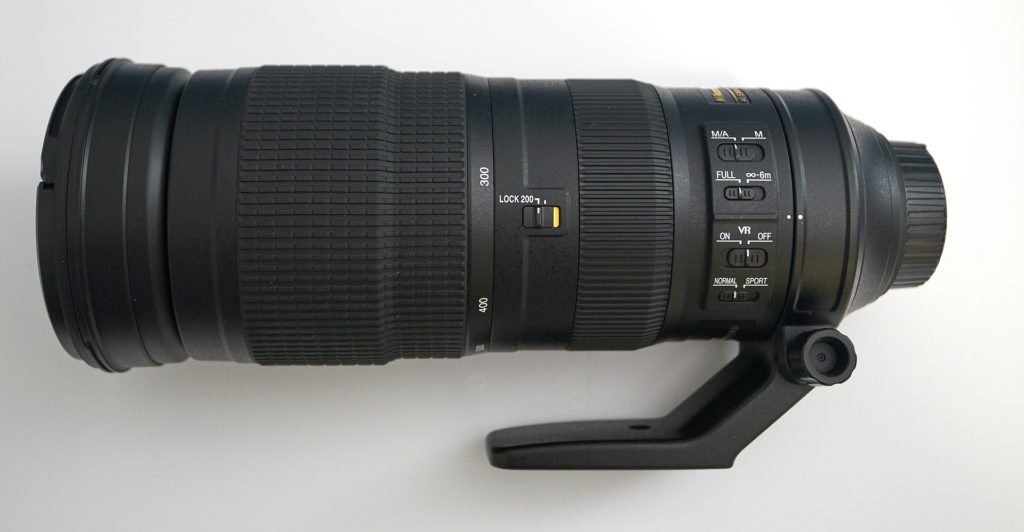
AF-S 200-500mm f/5.6 VR. The lens features a lock switch to prevent zoom creep while carrying the lens. When extended, the zoom position cannot be locked however.
The supplied plastic hood feels cheap (I had the same complaint about the much more expensive AF-S 500mm f/5.6 PF) and needs a few tries to get it right both when mounting and dismounting, it is quite annoying.
The 200-500 does not feature any exotic or light-weight materials in either its shell or in the optics. As a result it is not a very light-weight and compact lens, it is by no means huge but it is significantly larger and heavier than Nikon’s AF-S 500mm f/5.6 PF even with the zoom retracted to 200mm. At 5lbs, the zoom weighs noticeably more the PF prime and even more than the Canon EF 400mm f/4 DO IS II for comparison.
On the plus side the foot is made of metal and is very sturdy. When I first got this lens, I immediately removed the tripod collar since I will use it hand hold all the time. Removing the foot took out a few ounces but unfortunately the lens does not have any tabs on its body to attach a strap to it. This makes it uncomfortable to walk around with all day, while grabbing the lens by its barrel (there is no other way). The zoom ring is reverse and feels awkward at first, but I got used to it. Zoom can be locked, but only at its shortest length to prevent creeping.
The controls on the lens barrel include a focus limiter switch (full vs. 6m-inf), a switch to turn VR ON/OFF as well as a VR mode switch. If you use the lens hand hold set the VR to sport, it will prevent the finder image to “jump” when panning. Nikon tell us the VR mechanism can detect panning and also if the lens is on a tripod, regardless of the position of the VR switch.
The lens comes in a soft pouch that offers little protection. I highly recommend getting a TinkTank lens-changer series bag for it. It takes a rather large 95mm screw-in front filter which I don’t bother with. It does have a rubber gasket but Nikon don’t make any claims about dust/moisture sealing. I wouldn’t use it in the rain or snow.
The VR technology in this lens is nothing short of amazing, just like the AF-S 500mm f/5.6 PF, I can make tack sharp photos down to 1/50 sec at 500mm hand held with great consistency. VR is also dead silent and smooth, A+ there.
Optics and sharpness: the middle ground
Optics and sharpness is more important than build and finish, while I can live with a plastic body lens, I can’t live with soft images. Under controlled conditions (tripod, live view focus etc.) the 200-500mm produces acceptable results at all focal lengths, but I wouldn’t call it tack sharp, certainly not comparable to a pro super-telephoto lens. Below are 100% crops from RAW (shot with the high resolution D850) comparing the zoom against Nikon’s new bench mark for compact telephoto lenses, the AF-S 500mm f/5.6 PF. As you can clearly see the zoom is nowhere as sharp as the prime. You need to click on these images to view them at 100%. RAW converted with Capture One Pro with identical settings for both lenses.
Also you can see that the AF-S 200-500mm suffers from some focus breathing effect. A lens’s focal length is measured at infinity and it is typically shorter at closer focus distances. Zoom lenses typically suffer from this effect more, due to their complex design. Here the target was about 9 yards away from the tripod (typical shooting distance from a blind). The magnification of the zoom is lower than the prime (subject looks smaller) and its field of view is wider corresponding to a true focal length of about 450mm. At closer focus distances I expect its focal length to be even shorter, something to consider if you want to make close-ups with this lens.

100% crop from RAW. Left: AF-S 200-500mm f/5.6 VR at 500mm f/5.6. Right: AF-S 500mm f/5.6 PF at f/5.6. Nikon D850, RAW converted with Capture One Pro. Click on the image to view at 100%.
For those who are curious, below is a crop of the 200-500 plus the TC 14E-III. As you can see even under controlled conditions the image is soft and lacking in micro contrast. I would not recommend using this lens with an extender.

100% crop from RAW. AF-S 200-500 VR + TC14-E III left, AF-S 500mm f/5.6 PF + TC14-E III right. Nikon D850. Click on the image to view at 100%.
Sample variations?
When I first tried my AF-S 200-500 f/5.6 VR, I was a bit disappointed with the results. To be fair, coming from Canon’s excellent series II super telephoto lenses my expectations were quite high. While I wouldn’t, most casual photographers who do no specialize in birds in flight photography will probably call this lens sharp. I read some comments regarding sample variations, and in order to give the zoom its best chance, I ordered a second copy and also rented a third copy of the lens. I put all three of them side-by-side. The rental lens was a just hair worse than the other two, but you really have to look hard to spot the difference and certainly not something that would change my verdict. The two other performed exactly the same. It seems Nikon’s manufacturing process is quite consistent for this lens and I found no evidence of noticeable sample variation.
Field results
I had a chance to photograph a few raptors and a variety of shore birds with this lens before I got the 600mm f/4 E FL. The field sharpness was acceptable but only under ideal conditions, i.e. at close range and with the sun behind my neck, and after carefully sharpening the NEF files.
With both the 20 mega-pixel Nikon D5 and 45 mega-pixel D850, this lens did produce some pleasing images. I used optimal sharpening settings in Capture One Pro to convert the NEF files as well as careful selective output sharpening in Photoshop, just before saving the final JPEG’s. The output did not disappoint as you can see below (please see my Capture One Pro guide for details of my workflow). Note that to get the best results with this lens, the subject needs be large in the frame. Do not expect to make high-quality large crops when using this lens.
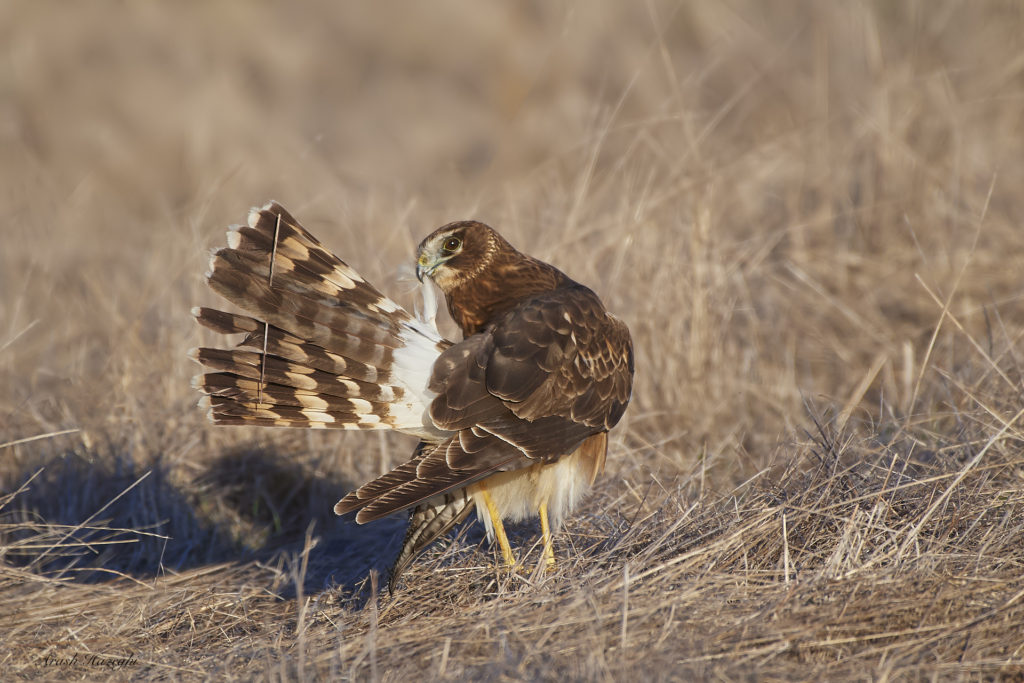
Northern harrier. AF-S 200-500mm f/5.6 VR, 500mm f/5.6 at 1/3200sec. ISO 1600 with Nikon D5. Hand held. Processed with Capture One Pro. Click on the image to enlarge.
The high resolution sensor in the D850 puts more burden on the optics and we can readily see some loss of micro-contrast at pixel level, the files just lack that punch when viewed at 100% but the final presentation is certainly acceptable, after down-sampling and sharpening of course, as explained above.

Wimbrel with shell fish, Nikon AF-S 200-500mm f/5.6 VR at 500mm f/5.6 at 1/3200sec. ISO 1600 with Nikon D850. Hand held, processed with Capture One Pro. Click on the image to enlarge.
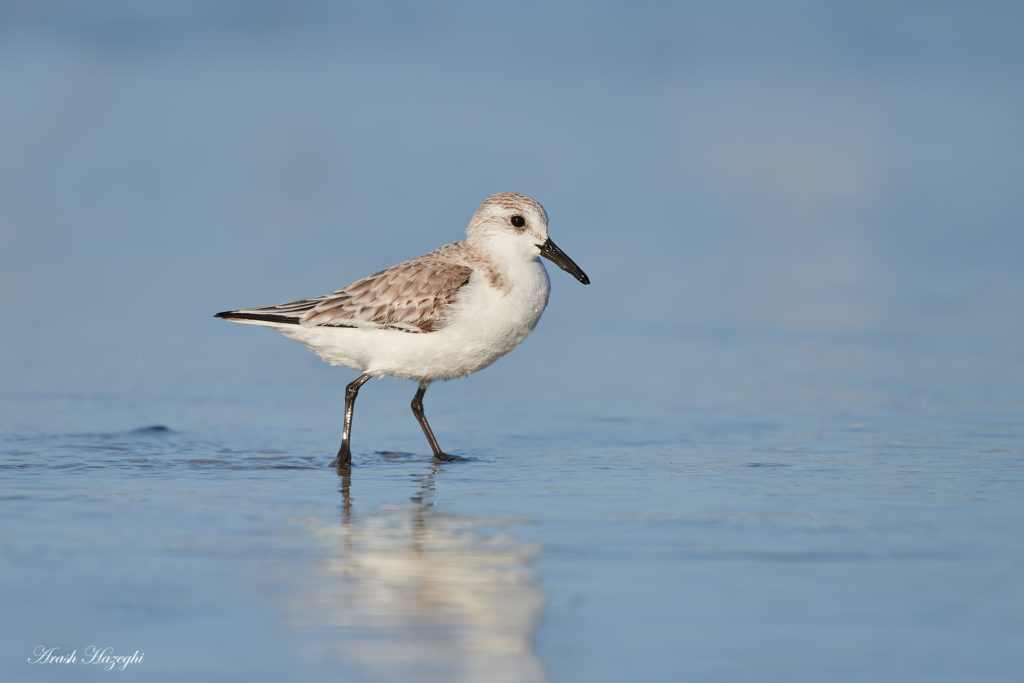
Sanderling. AF-S 200-500mm f/5.6 VR, 500mm f/5.6 at 1/3200sec. ISO 400 with Nikon D850. Hand held. Processed with Capture One Pro. Click on the image to enlarge.

Wimbrell, Nikon AF-S 200-500mm f/5.6 VR at 500mm f/5.6, 1/3200sec. ISO 800 with Nikon D850. Hand held. Processed with Capture One Pro. Click on the image to enlarge.
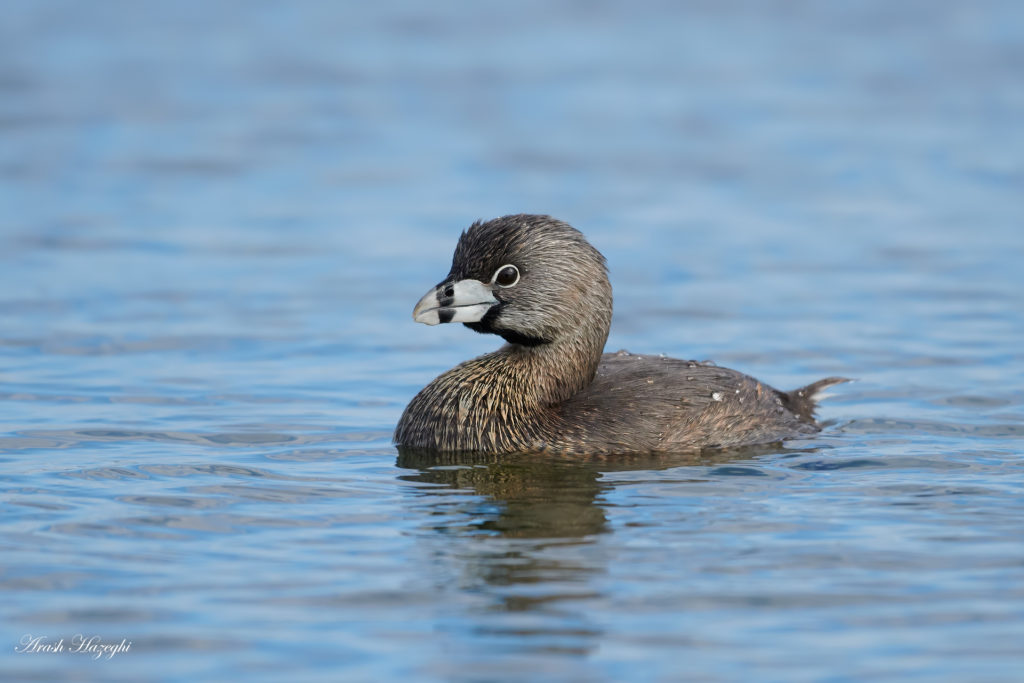
Juvenile grebe, AF-S 200-500mm f/5.6 VR at 500mm f/5.6. ISO 1000 with Nikon D850. Hand held. Processed with Capture One Pro. Click on the image to enlarge.
Specific issues: ghosting
Conditions in the field are not always ideal. After shooting several thousand frames I noticed that when the sun is illuminating the subject at a shallow angle (moderate side light), the lens can exhibit ghosting: a visible faint halo or double-image along the highlight edges. The examples below demonstrate this issue. All three copies of the lens exhibited this behavior. The 200-500 does not feature Nikon’s nano-crystal coating, other exotic coatings, or a fluorite element found in their high-end lenses and thus may suffers from some internal reflection under certain circumstances. The ghosting is clearly visible at 100% and is unfortunately very difficult if not impossible to remove in RAW conversion or post processing. If the subject is large in the frame, chances are it may not show in the final presentation.
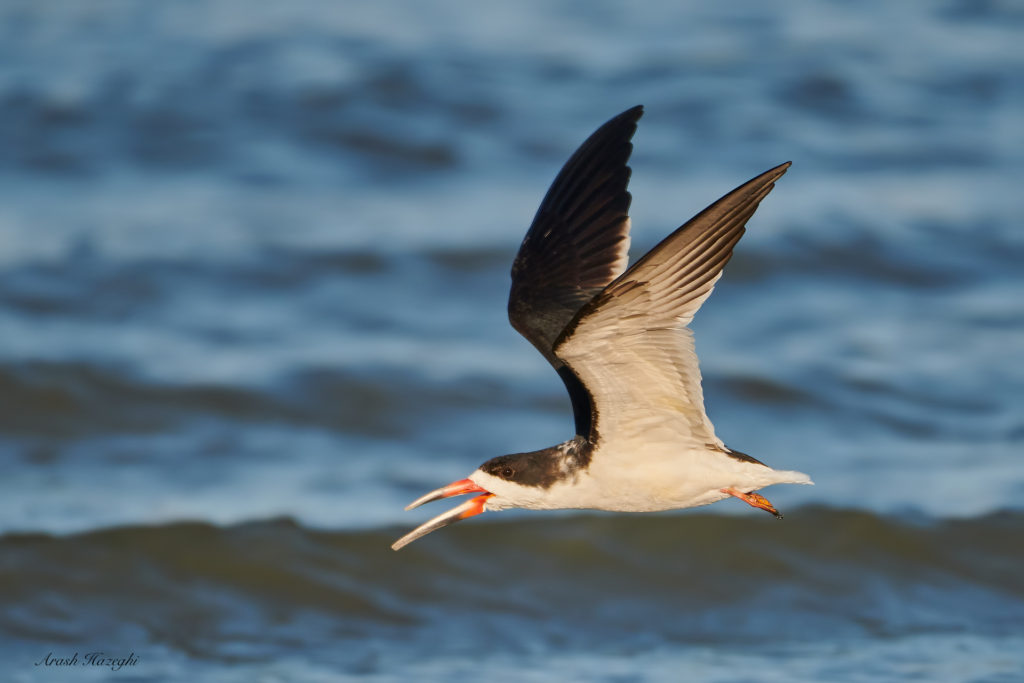
Black skimmer, Nikon D850, AF-S Nikkor 200-500 f/5.6 VR. ISO 640 f/5.6 at 1/4000sec hand held. Processed with C1P. Notice the faint halo around the beak. Click on the image to expand.
Another example of this issue with the D5 (this one was taken with the second copy of the lens). Ghosting can be seen at the edges of harrier’s head and beak.
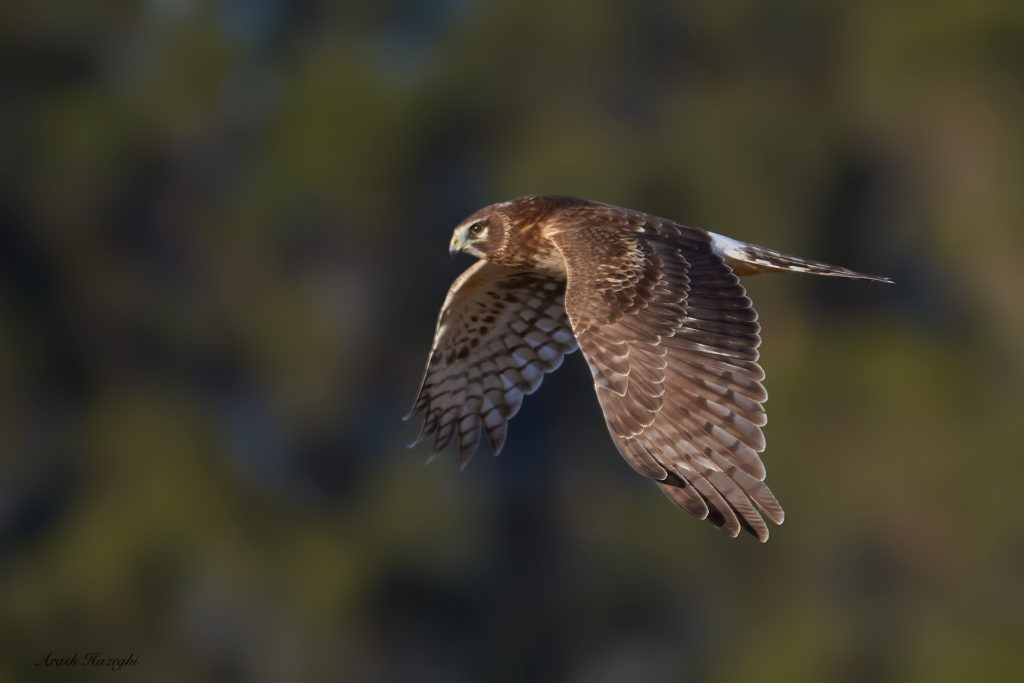
Female northern harrier (side light), Nikon D5, AF-S Nikkor 200-500 VR, ISO 500, f/5.6 at 1/3200sec, hand held. Processed with C1P. Notice the halo around the head and the far wing.

Northern harrier. AF-S 200-500mm f/5.6 VR, 500mm f/5.6, ISO 1250 with Nikon D5. Hand held. Processed with Capture One Pro, click on the image to expand. In ideal conditions there is no visible ghosting.
Generally, it is preferable to have thew sun behind your neck where possible so the “perfect” images are less likely to be impacted by this issue.
The other issue I noticed was a lack of micro-contrast and some softness at pixel levels when shooting on the CA coast. The heat shimmers at this location can be strong and often tax the optics. The 200-500 is unforgiving and shows its weakness here, especially at longer distances. As mentioned before, I do not recommend using this lens with the TC14E-III.
AF
This lenses is fitted with Nikon’s AF-S silent wave motor (SWM), a fancy name for an ultra-sonic servo motor. The AF glides into lock smoothly and surely but slowly. At full range it is too slow for initial acquisition for most BIF, but with the limiter set to far range the performance improves. With the correct pre-focus technique the servo is able to track even such challenging birds as a plover in flight.
The examples below made with the gripped D850 are more of a demonstration of the camera’s AF prowess. Once acquired, the AF is able to stay locked on the bird for a very long period. As a result, late acquisition and/or AF bumping techniques (as described in detail in my BIF guide for Canon) are often not necessary for Nikon D850/D5 cameras (however there are several other tricks to use the system to its full potential). This gives the photographer a longer window of time to acquire and partially makes up for the slow servo drive of the zoom.
Having said that, this lens is not able to lock on a fast BIF mid field, or track a more challenging BIF such a semipalmated plover with tail wind, even with pre-focus technique, it is just too slow. To be honest one cannot ask too much for $1300. Overall, this lens wouldn’t be a BIF lens for me.

Black-bellied plover in flight. AF-S 200-500mm f/5.6 VR at 500mm, f/5.6 at 1/3200sec. ISO 640, Nikon D850. Hand held RAW converted with Capture One Pro. Click on the image to enlarge.
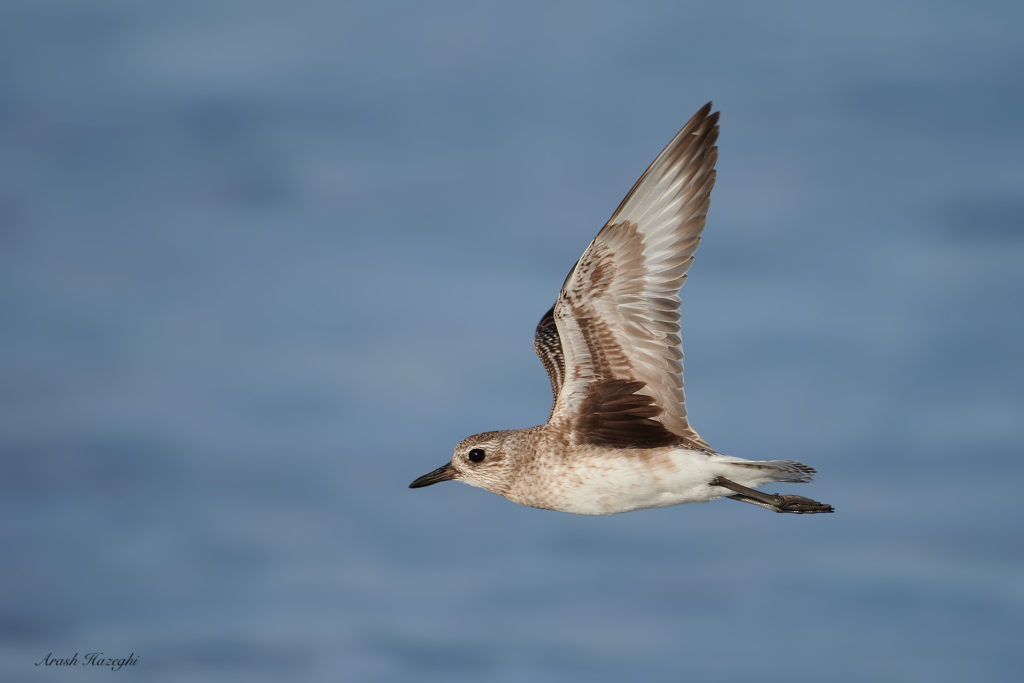
Black-bellied plover in flight. AF-S 200-500mm f/5.6 VR at 500mm, f/5.6 at 1/3200sec. ISO 640, Nikon D850. Hand held RAW converted with Capture One Pro. Click on the image to enlarge.

Marbled godwit, AF-S 200-500mm f/5.6 VR, at 500mm f/5.6, 1/3200 sec. ISO 640 with Nikon D850, hand held. Processed with Capture One Pro. Click on the image to expand.

Forster’s tern. AF-S 200-500mm f/5.6 VR, 500mm f/5.6 at 1/3200sec. ISO 1250 with Nikon D850. Hand held. Processed with Capture One Pro. Click on the image to enlarge.
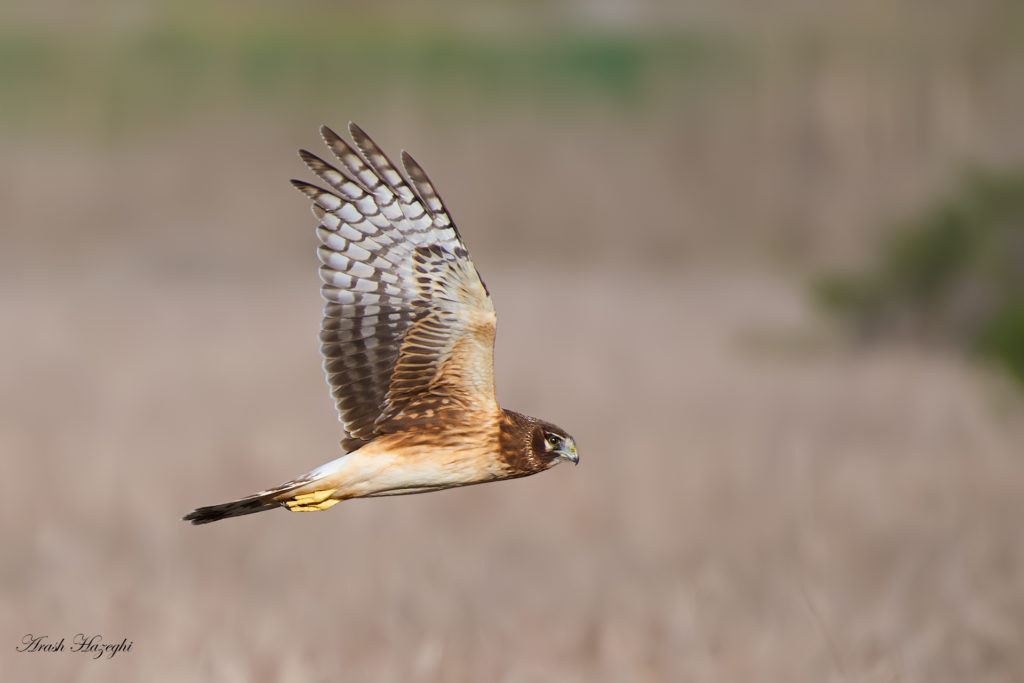
Northern harrier. AF-S 200-500mm f/5.6 VR at 500mm, f/5.6 at 1/3200sec. ISO 800 Nikon D5, hand held. Processed with Capture One Pro. The zoom struggles a bit to deliver the same level of details on the raptors seen in the images take with the AF-S 600mm FL or the 500nn f/5.6 PF lenses. Click on the image to expand.
Wildlife: Where the 2-5 shines
I also had a few brief opportunity to shoot some larger subjects with the 200-500, namely some sea lions and seals near Monterrey, CA. The results were more satisfying than shooting birds, with no fine feather details to expose the weakness and the subject generally much larger the 200-500 had a much easier time delivering great frames. I imagine the zoom being a great safari lens and at this price you can just buy two and not worry about it taking punishment during your trip.
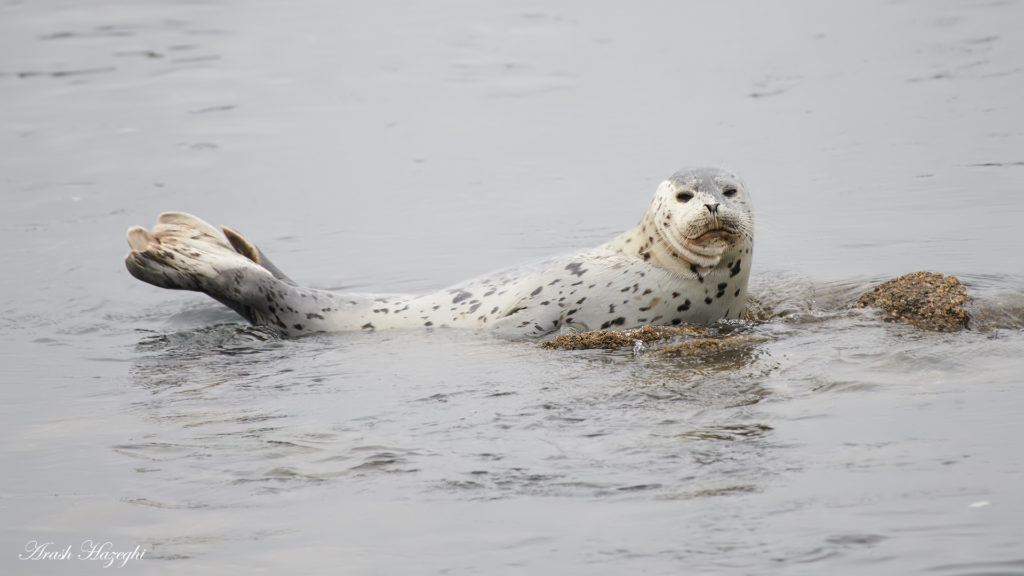
Seal, AF-S 200-500mm f/5.6, 500mm f/5.6 at 1/3200sec. ISO 500 with Nikon D850. Hand held. Processed with Capture One Pro 11. Click on the image to enlarge.
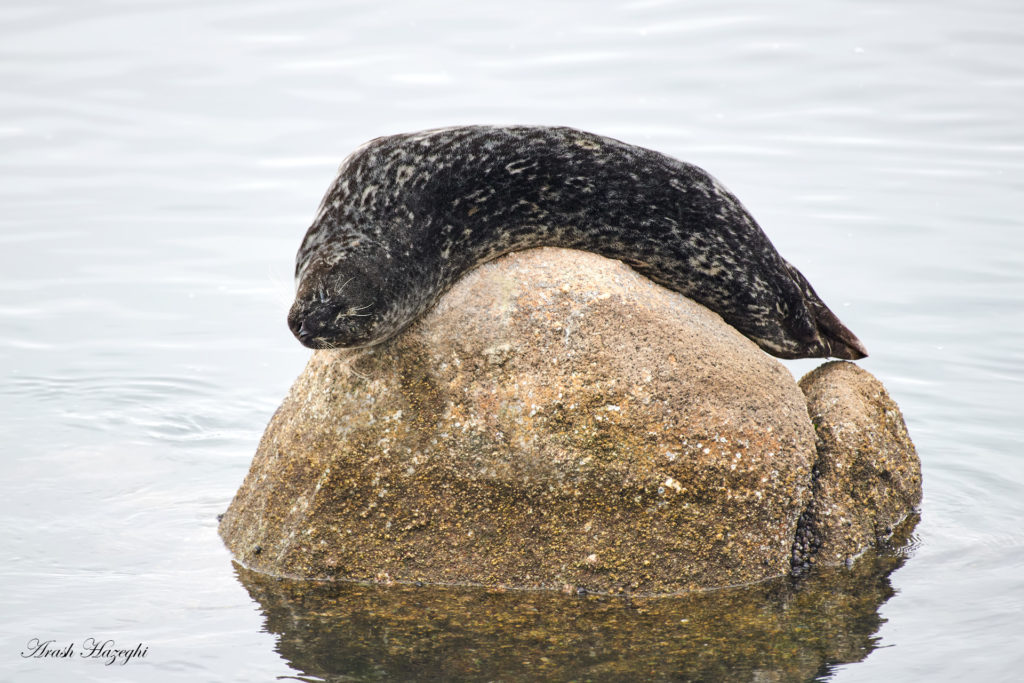
Seal, AF-S 200-500mm f/5.6 VR, 500mm f/5.6 at 1/2000 sec. ISO 500 with Nikon D850. Hand held. Processed with Capture One Pro. Click on the image to enlarge.
Final thought and conclusion
The Nikon AF-S 200-500mm f/5.6 VR is an entry level lens for beginners, amateurs and wildlife enthusiasts. Compared to your plastic kit lens or third-party mega zooms, it opens a whole new world of possibilities, images and the pleasure of capturing them and does not shy from taking the challenge when given. It is a great lens to develop your skills with. Given its modest focal length and lackluster performance with the TC, it is best suited for the high resolution cameras such as the D850 and the D500. Working pros and those who demand critical sharpness and/or AF performance worth of BIF photography, need to look elsewhere, at the Nikon AF-S 500mm f/5.6 PF and can skip this lens. After acquiring the 500 PF, I quickly sold the 200-500 and I haven’t looked back since.
Pros:
+ Low cost
+ Excellent VR for hand held shot (where subject movement is not limiting)
+ Relatively light and compact if a bit clunky
+ Acceptable results after processing and under ideal conditions
+ consistent performance across the zoom range
+ removable tripod collar
Cons:
-Slow AF even with the limiter set to far range.
-Not tack sharp to the critical eye. Lacks micro-contrast and pixel-level sharpness when rendering fine feather details.
-Ghosting when shooting at longer distance with side light.
-Noticeable focus breathing.
-Useless with TC14-E III.
-Zoom can only be locked when fully retracted.
– Construction quality leaves a bit to be desired.
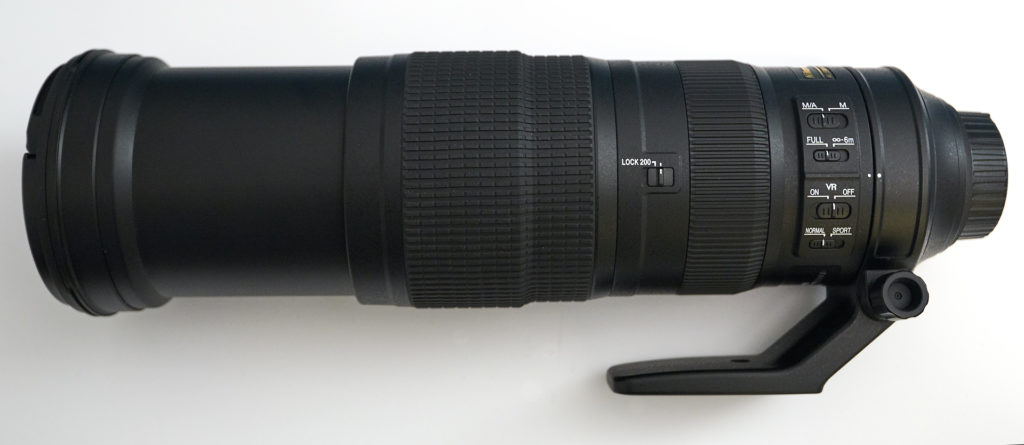
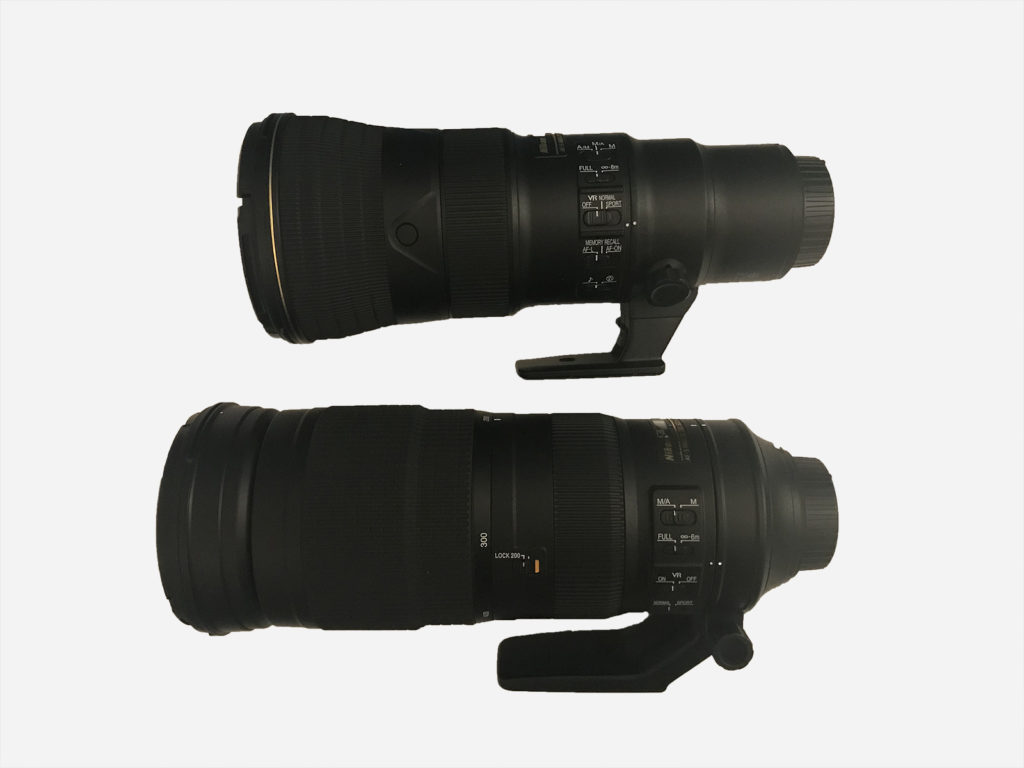
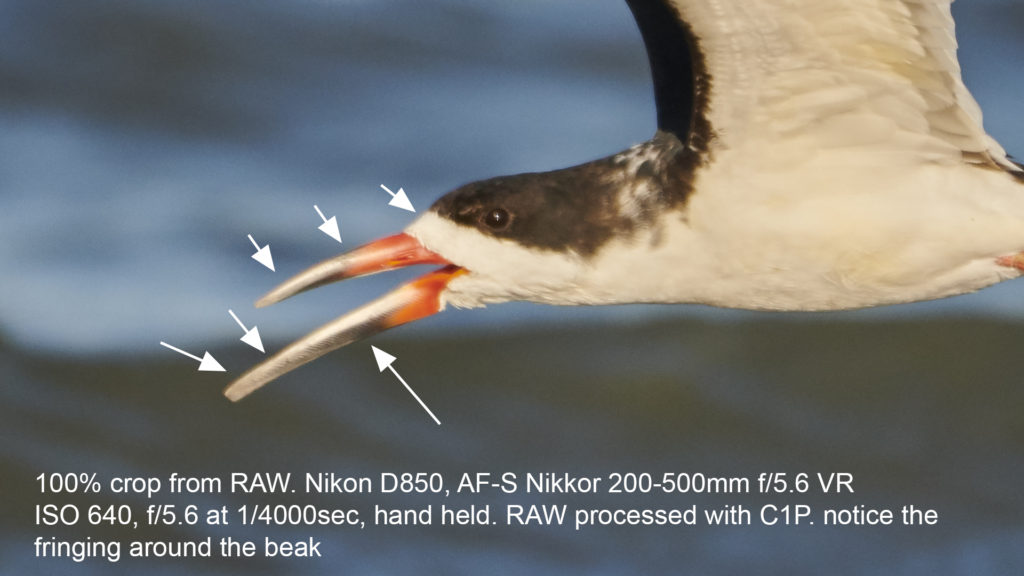
thanks -very thorough review!
Saving up for a good used D500. From what I see and as you note the optimal and most common body pairing for folks at my level is the D500.
Great review, I my self have this lense and use it at times when the 600 is too heavy to hold for longer periods of time. I am thinking of replacing this lens with the new 500pf, but first I should read your review of the new 500 Pf
Thanks for the excellent review. It illustrates, with good testing, what many of us already know by subjective personal experience. The Nikon 200-500 is not the equivalent of a fixed focal, expensive fast lens. In fact, no current telephoto, made by any major camera manufacturer, is the equivalent of a fixed fast lens, even made by a secondary manufacturer. Most are made cheaper but the expensive, and heavy, Canon 200-400 f/4 with the built-in 1.4 teleconverter still cannot compete with Canon’s 500 or 600 f/4 fixed telephoto lens when it comes to sharpness. The only exception is the old Canon 400 f/5.6. The current, second generation, Canon 100-400, provides better sharpness.
Professionals, such as Ari, will never be satisfied with telephoto quality at maximum zoom. I, on the other hand, am forced to rely on a telephoto, when shooting small birds, such as warblers at Maggees Marsh, where a subject, that may be at a far distance, when first observed, suddenly arrives at your feet a moment later.
Despite the above, most photographers can and will take outstanding photos with today’s zoom lens, including the ones which are not optimally constructed. The reason is that some of those shots will be of birds which are close and there is no fixed telephoto which will give you a better photo when the bird is far away, as a zoom lens, or any lens for that matter when a bird is a lot closer. The object is to get physically close to the subject and then use the telephoto to get the subject closer to the camera sensor. That is not always possible, as with waterfowl, or with birds of prey, but when it is possible the fixed, or zoom telephoto choice, becomes less of an issue. In fact, the zoom may actually provide an advantage since it can focus closer and go where the fixed lens may not be able to focus at all. The best way to overcome the disadvantages of less than maximally available sharp lenses is to move closer to the bird or get the bird to move closer to us.
This lens probably works best with a D500 rather than a D850.
D850 and D500 have similar pixel size, the lens will perform similarly on these two cameras.
Why don’t you recommend third-party lenses, for example the Sigma or Tamron 150-600mm lenses?
Hi Steve, the image quality and the AF does not meet my standards. Even The Nikon 200-500 doesn’t stack up to my expectations for that matter.
best
One advantage of the Nikon 200-500 over the 500mm is versatility. Let’s say a Field Sparrow pops up and perches on a branch. If I am using a prime lens, I can’t afford to move around a lot in composing the shot or the bird will be gone. The zoom lets you adjust to the movements of birds without the photographer having to move as well. Of course, I know the images would be sharper with a prime lens, but if I am on a trip to Costa Rica say, and with a group, I can’t be moving all around trying to find the shot with a prime lens; the zoom gives the birder a huge tactical advantage.
Hmm, I think you’ve accounted for something I’ve been noticing about this lens … Ghosting. I had just chocked it up to conditions but had noticed it happening to often for my liking.
[…] is priced higher at $2800 and Nikon’s modestly priced 200-500mm f/5.6 lens. I reviewed the Nikon zoom back in 2018. For bird photography, Sony wins the spec race right off the bat reaching to 600mm at just a touch […]
I’ve been reviewing the reviews of this lens (intentional) and find it hard for anyone to challenge any perceived short-comings of this $1000 lens. Let me go one step further. I’ve yet to find any lackluster quality images, anywhere, with this lens – at least by experienced photographers. Let’s take the images posted here. They are outstanding for any lens, much less a $1000, “hobbyists” lens. Seriously people, let me turn this around so it’s more of a glass is half full scenario rather than a glass half empty review. The review should end something like this: One of the best reach zoom lenses you can buy – period! Are we looking at the same output? These images are great. I see worse images with glass costing 8x higher. If this lens were $6-10K, the reviews would suggest what a quality piece of glass this is, but I’m afraid the low cost is skewing reviews. Geez people.
Hi Roland, you are correct that the photographer’s level of experience, talent and skill is the most important factor in making great looking images. A novice user is likely to make worse images with a $20,000 lens than a highly acclaimed photographer with a $1000 lens but that is not proof that the $1000 lens is better than the $20000 lens. The Nikon zoom lens is a good package but it is far from perfect. You probably have not seen the results of a more capable lens in the hands of a skilled photographer if you think this lens is flawless. It is not for those with critical eyes. The Sony 200-600 zoom lens is for example significantly better than this lens although it is a bit more expensive, but it is not $10,000 either. we all wish a Kia would be as good as a Porsche, but it is not. There are better options than this lens especially if one is to look at used market. With F mount all but dead, some great lenses can be now purchased at great prices so I would not look at this lens in 2022.